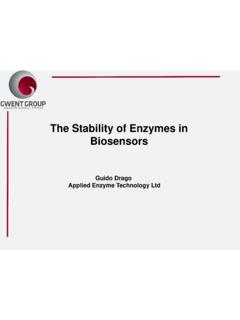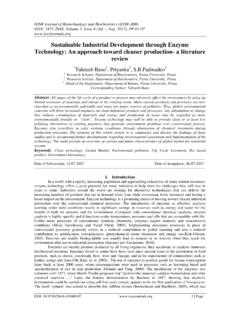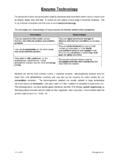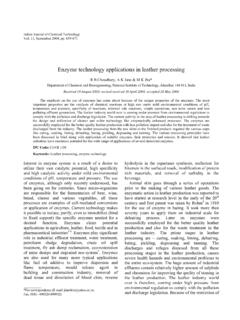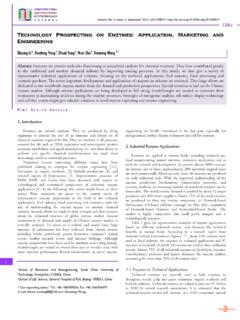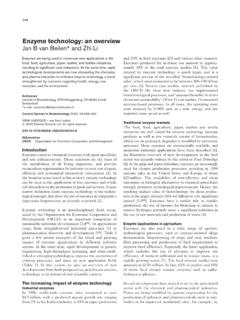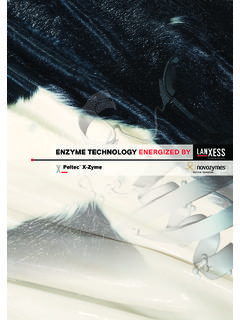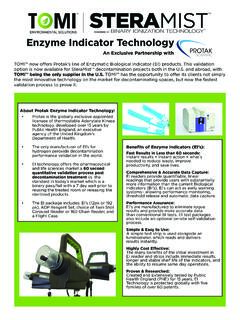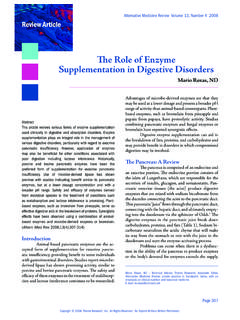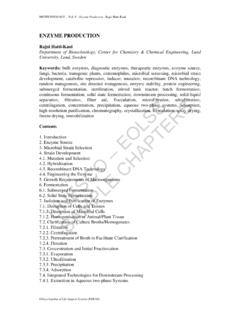Transcription of Fermentation Enzymes - White Labs
1 W h i t e l a b s Fermentation Enzymes Made with technology from version 1. About Enzymes What are they? Enzymes are proteins complex amino acid structures made by live cells, although not all proteins are Enzymes . Where do they come from? Enzymes have many natural sources including: Microbial (yeast or bacteria). Plant (papaya, pineapple). Animal (pancreatic, for example). How do they work? Enzymes bring molecules together in optimal orientations to make and break chemical bonds. They are CATALYSTS of biological systems All chemical reactions need and use energy Enzymes LOWER the energy needed for activation of reactions Determine pathway of chemical reactions Mediate transformation of energy from one form to another (releasing free energy). They are SPECIFIC in their reactions Each enzyme is responsible for a single chemical reaction or a set of closely related reactions But they can act on a wide range of molecules 2.
2 WITH ENZYME. PRODUCT. WITHOUT ENZYME. TIME. Why are they important in Fermentation ? Many aspects of Fermentation require enzymatic reactions in order to pro- ceed. Extracting fermentable sugars from grains are critical to the success of yeast Fermentation , and production of alcohol could not occur without the work of amylase Enzymes to break down starch into simple sugars that are usable by yeast. Also, many steps of the metabolic pathways used by yeast are enzyme-dependent. Without Enzymes , Fermentation would not be possible. Fermentation Enzymes White Labs Fermentation Enzymes are packages with products made by technology from DSM Unlimited, and come in home-brew 1L, and 10L. sizes that are ready to use. All of our enzyme products are sources from non-genetically modified organisms.
3 They are also Kosher approved and comply with current Food & Drug Administration standards for Good Manufacturing Practice. Enzymes should be stored at 4-8 , which will minimize activity loss to less than 5% over 36 months. See individual product descriptions for specific dosage rates. 3. AMINO-QUIK - WLN4200. Liquid papain for chill proofing beer Product Description ---------------------------------------- --------------------------- AMINO-QUIK is a liquid vegetal papain extracted from Carica papaya. Function ------------------------------ Brewers must ensure that the finished beer they produce is as clear and bright as possible for answering consumer demand. However, sometimes chill haze appears progressively when beer is stored at low temperature. Haze is composed of proteins, polyphenols, carbohydrates and inorganic compounds such as iron or copper.
4 Polyphenols and proteins associate in hydrogen, then covalent bonds in time, making haze irreversible. Papain is a cystein protease that degrades protein fraction of beer, preventing further association with polyphenols. AMINO-QUIK acts specifically on the haze forming protein components by hydrolyzing bonds with leucine or glycine. Chill proofing with AMINO-QUIK effectively prevents chill haze without physically removing other important beer components. AMI- NO-QUIK does not impart any odor or taste to the beer. Application --------------------------------------- AMINO-QUIK is easy to use. It must be added to the beer at maturation stage at 1 to 3 ml/BBL into the lagering tank or when the beer is trans- ferred prior to final filtration. Optimal temperature is 55-65 C.
5 Just before use, to ensure adequate mix- ing, it should be diluted at a dosage of 1 Liter in 4 Liters of beer or water. CLARITY-FERM - WLN4000. A highly specific endo-protease to prevent chill haze in beer and reduce levels of gluten 4. Product Description ---------------------------------------- --------------------------- CLARITY-FERM is a product containing a highly specific endo-protease which only cleaves polypeptides at the carboxyl end of the amino acid proline. Protease is derived from Aspergillus niger. Function ------------------------------ Chill haze in beer results from the precipitation of complexed polyphenols and proteins during cold storage. The nature of this precipitation has been shown to be the result of hydrogen bonding between the polyphenols and the proline-rich fraction of particular polypeptides.
6 This haze develops over time and, initially, is reversible (haze disappears when the tempera- ture of the beer increases). As the hydrogen bonding becomes stronger this chill haze can become permanent. CLARITY-FERM will prevent the precipitation of complexed polyphe- nols and proteins by hydrolyzing the sensitive (haze-active) polypeptides in the region where such hydrogen bonding occurs, specifically the amino acid Proline, The specificity of the enzyme ensures that no other beer pa- rameters, such as foam/head retention or flavor are affected. This easy to use enzyme can be used on all types of brewing ingredients and is a cost effective product to replace silica gel or PVPP. Simply add when pitching yeast, and CLARITY-FERM will do its work during Fermentation .
7 When Fermentation is complete, chill haze has already been addressed. In addition to eliminating chill haze, CLARITY-FERM significantly reduces the gluten content in beers made with barley and wheat by specif- ically breaking down the Proline fraction, making up the gluten protein. A CLARITY-FERM treated beer made from barley or wheat usually tests below 20 ppm of gluten, the current international standard for gluten free. *THE TTB ISSUED INTERIM LABELING GUIDELINES IN 2012. FOR BEERS MADE WITH GLUTEN CONTAINING GRAINS, AND IT STATES: 5. TTB will allow use of the statement Processed or Treated or Crafted to remove gluten, together with a qualifying statement to inform consumers that: (1) the product was made from a grain that contains gluten; (2) there is currently no valid test to verify the gluten content of fermented prod- ucts; and (3) the finished product may contain gluten.
8 TTB will only approve label applications with the above claims if it con- tains a detailed description of the method used to remove gluten and R5. Mendez Competitive ELISA assay for the finished product showing a response of less than 20ppm gluten (and the manufacturer of the assay). Application --------------------------------------- CLARITY-FERM can be used with all kinds of malts and other raw mate- rials. CLARITY-FERM is added to cooled wort at the beginning of fermenta- tion. The required dose rate is determined by: - The percentage of barley malt, raw barley and/or wheat of the total grist composition;. - The specific gravity (Plato) of the wort at the beginning of Fermentation ;. - The shelf-life required (months). Note: There is no requirement to treat any adjuncts derived from maize grits or rice with CLARITY-FERM.
9 Recommended Dose Rates of CLARITY-FERM. for Chill Haze Reduction*. Product Shelf-Life Requirement Raw Material (by extract) Raw Material (by extract) >12 months 100% malted barley 6 ml/BBL 10 ml/BBL. 60% malted barley 3 ml/BBL 6 ml/BBL. *Recommended dose rates based on a 12 P wort. Increase dosage proportionally with increasing wort gravity. 6. Recommended Dose Rates of CLARITY-FERM for Gluten Reduction*. Raw Material (by extract) Dosage Rate 100% malted barley 12 ml/BBL. 60% malted barley 6 ml/BBL. *Reduced to <20ppm gluten. Recommended dose rates based on a 12 P wort. CRYSTALZYME PLMX - WLN4600. Enzyme system for processing fruit and vegetable mash Product Description ---------------------------------------- --------------------------- Crystalzyme PMLX is a proprietary enzyme system produced by the controlled fermentations of non-genetically modified strains of Aspergillus niger.
10 And Trichoderma reesei. The enzyme system includes pectinases, cel- lulases, hemicellulases, and arabinase. Crystalzyme PMLX hydrolyzes and depolymerizes (breaks down) fruit and vegetable pectin and other select- ed complex polysaccharides. The food grade liquid contains no chemical preservatives Function ------------------------------ Crystalzyme PMLX is designed for the processing of milled fruit and veg- etable mashes. It contains standardized levels of pectinase, cellulase, and hemicellulase activities, and takes advantage of enzyme synergies to effi- ciently break down soluble and colloidal pectin, araban, and other selected complex polysaccharides. Crystalzyme PMLS rapidly reduces the viscosity of fruit and vegetable mashes in maceration applications, enhancing solids separation employing centrifugal separation (decanter) equipment, increasing decanter and press efficiency and productivity, and increasing the release and recovery of solu- ble solids, and total juice yields.

